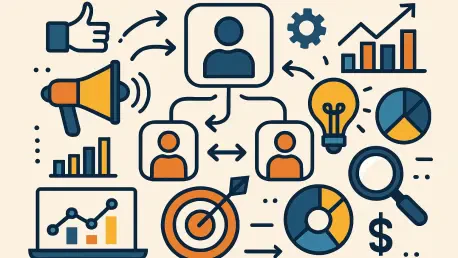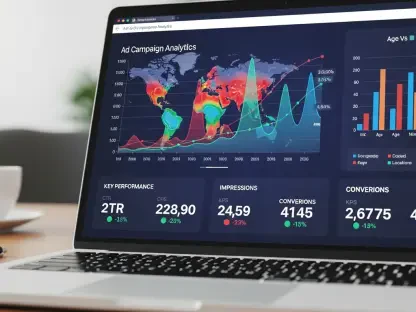I’m thrilled to sit down with Anastasia Braitsik, a global leader in SEO, content marketing, and data analytics. With her extensive expertise in digital marketing, Anastasia has been at the forefront of navigating transformative shifts in the industry. Today, we’re diving into the fascinating world of disruptive innovation and the rise of Positionless Marketing—a game-changing approach that’s reshaping how brands connect with customers. Our conversation explores the limitations of traditional marketing models, the empowering capabilities of Positionless Marketing, the market forces driving this change, and real-world examples of its impact.
Can you break down Clayton Christensen’s theory of disruptive innovation in simple terms for those who might not be familiar with it?
Absolutely. Clayton Christensen’s theory of disruptive innovation explains how new technologies or business models can completely transform industries. It often starts with smaller players or simpler solutions that seem less threatening at first, but they lower barriers, make things more accessible, and eventually change the entire competitive landscape. Think of it like how streaming services started as a niche option but ended up revolutionizing how we consume entertainment, pushing traditional cable companies to adapt or fall behind. In essence, disruption rewrites the rules by empowering more people with tools and opportunities that were once out of reach.
How does this theory connect to the shifts we’re seeing in the marketing world right now?
Marketing is experiencing a classic case of disruptive innovation with the move away from rigid, siloed structures toward more fluid, empowered approaches like Positionless Marketing. Christensen’s idea of democratizing access applies perfectly here—traditional marketing often locked powerful tools and insights within specific roles or departments, slowing everything down. Now, with new platforms and technologies, every marketer can access data, create content, and optimize campaigns on their own. This shift is upending the old assembly-line model and forcing the industry to rethink how teams operate to keep up with customer demands.
Let’s dive into Positionless Marketing. Can you explain what it is and how it stands apart from traditional marketing methods?
Positionless Marketing is about breaking down the barriers of fixed roles in marketing teams. Traditionally, marketing worked like an assembly line—data analysts handed insights to strategists, who passed ideas to creatives, who then sent campaigns to execution teams. It was slow and full of delays. Positionless Marketing flips that on its head by giving every marketer the ability to handle data, create assets, and optimize results independently. It’s powered by platforms that integrate these capabilities, so you’re not waiting on someone else to move the needle. It’s faster, more agile, and aligns much better with today’s need for speed and personalization.
Why do you think the old assembly-line model of marketing is struggling to keep up in today’s environment?
The assembly-line model was built for a different era, when customer expectations and technology moved at a slower pace. Back then, you could afford weeks to launch a campaign. Now, consumers expect brands to respond in real time—whether it’s a personalized offer or a timely social media interaction. The old model, with its multiple handoffs between departments, creates too many bottlenecks. By the time a campaign goes live, the opportunity might be gone, or worse, the message feels irrelevant. It’s just not equipped to handle the speed and complexity of modern customer journeys.
What are some common delays or pain points in that traditional process that you’ve seen frustrate marketing teams?
One big issue is the waiting game between teams. For instance, data analysts might take days to pull insights from customer behavior, then pass them to strategists who need another few days to brainstorm. By the time the creative team gets the brief, the data might already be outdated. Then, execution can get stalled waiting for approvals or technical setup. I’ve seen teams miss critical windows—like a trending topic or a seasonal spike—because they couldn’t move fast enough. It’s frustrating because everyone’s working hard, but the structure itself is the roadblock.
How do these delays affect a brand’s ability to build meaningful connections with customers today?
Delays can be a death knell for customer engagement in today’s fast-paced world. If a brand can’t respond to a customer’s need or interest in the moment—say, offering a discount right when they’re browsing or acknowledging a social media comment instantly—it risks looking out of touch. Customers notice speed and relevance. When a campaign finally launches but misses the mark because it’s late or off-target, trust erodes. Over time, brands stuck in slow processes lose ground to competitors who can pivot quickly and deliver personalized experiences on the spot.
Can you walk us through the three core powers of Positionless Marketing—Data Power, Creative Power, and Optimization Power—and what they mean for marketers?
Sure, these are the pillars that make Positionless Marketing so transformative. Data Power means every marketer can access and analyze customer insights instantly, without waiting for a data team to run reports. It’s about targeting the right audience with precision. Creative Power gives marketers tools to produce campaign assets—like emails or visuals—on their own, skipping the back-and-forth with designers. Finally, Optimization Power uses AI to fine-tune campaigns in real time, through automated testing and personalized journeys, without needing an analyst to crunch numbers. Together, these powers let marketers own the entire process from idea to impact, cutting out delays.
How does having direct access to data insights change the way campaigns come together?
It’s a game-changer. When marketers can dive into customer data themselves, they spot trends and opportunities as they happen. Imagine noticing a spike in interest for a product category right away and being able to target those customers with a tailored message within hours, not days. It removes the middleman, so there’s no miscommunication or lag. Campaigns become more relevant because they’re based on fresh insights, and marketers feel more confident making decisions since they’re directly connected to the data driving their strategy.
What does Creative Power bring to the table, and how does it help get campaigns out the door faster?
Creative Power means marketers can create professional-grade content—think email copy, social posts, or even visuals—without waiting for a dedicated creative team. With intuitive tools and templates, someone with no design background can still produce polished assets that are ready for specific channels. This slashes turnaround time because you’re not stuck in a queue for a designer’s availability or revisions. I’ve seen teams go from ideation to launch in a single day because they could handle the creative side themselves. It’s empowering and incredibly efficient.
How does Optimization Power, especially with AI-driven journeys, help marketers improve outcomes without needing constant analyst support?
Optimization Power leverages AI to take the guesswork out of campaign performance. It automatically tests different versions of a campaign—like subject lines or offers—and adjusts on the fly to what’s working best. AI can also map out personalized customer journeys, ensuring each interaction feels relevant. Marketers don’t need to wait for an analyst to interpret results or suggest tweaks; the system does it in real time. This means better results—higher engagement, conversions—without the traditional dependency on specialized roles. It’s like having a strategist in your pocket.
In what ways does Positionless Marketing make marketing teams more agile and independent compared to the old model?
It completely transforms team dynamics. In the old model, you’re tethered to other departments, waiting for their input or approval at every step. Positionless Marketing cuts those ties by equipping each marketer with end-to-end capabilities. Teams can brainstorm, build, and launch campaigns without endless coordination. This independence fosters agility—marketers can react to market shifts or customer feedback instantly. It also boosts morale because people feel ownership over their work, rather than being just one cog in a slow machine.
What are some of the toughest challenges marketers face with the explosion of customer data in today’s landscape?
The sheer volume of data is overwhelming. Marketers are drowning in information from websites, apps, social platforms, and more, but the challenge is turning that into actionable insights quickly. Many teams lack the tools or bandwidth to process it in real time, so they’re stuck with outdated snapshots of customer behavior. There’s also the pressure to maintain privacy while personalizing—striking that balance is tricky. Without the right systems, data becomes a burden rather than an asset, and marketers miss out on opportunities to connect meaningfully.
How have rising customer expectations, like the demand for real-time engagement, fueled the need for something like Positionless Marketing?
Customers today expect brands to know them and respond instantly. If they browse a product online, they want a follow-up offer or reminder right away, not a week later. They crave interactions that feel personal—whether it’s a message tied to their location or a recommendation based on past purchases. Traditional marketing, with its slow handoffs, can’t keep up with that immediacy. Positionless Marketing meets this demand by enabling marketers to act in the moment, delivering tailored experiences at the speed customers expect, which builds loyalty and trust.
What role is artificial intelligence playing in making Positionless Marketing a reality right now?
AI is the backbone of Positionless Marketing. It powers the ability to analyze huge datasets instantly, uncovering insights that marketers can act on without delay. It drives creative automation, helping generate content ideas or visuals tailored to specific audiences. And it’s critical for optimization, using algorithms to refine campaigns and personalize customer journeys in ways humans couldn’t do at scale. AI takes complex tasks that once required entire teams and puts them in the hands of individual marketers, making this disruptive approach not just possible, but practical today.
I’d love to hear about a real-world example. How did Caesars Entertainment manage to shrink their campaign launch time from five days to just five minutes?
Caesars Entertainment is a fantastic case of Positionless Marketing in action. They adopted a platform that gave their team access to integrated data, creative tools, and optimization features. Instead of waiting days for data pulls, creative approvals, and technical setups across multiple departments, a single marketer could handle everything—targeting the right audience, crafting the message, and launching the campaign—all from one place. This streamlined workflow cut out the back-and-forth, shrinking a five-day process into just five minutes. It’s a perfect example of how breaking down silos can revolutionize speed and impact.
What’s your forecast for the future of Positionless Marketing and its impact on the industry over the next few years?
I believe Positionless Marketing will become the standard for how teams operate in the coming years. As customer expectations continue to rise and technology advances, brands won’t have a choice but to adopt more agile, independent models. We’ll see even deeper integration of AI, making tools more intuitive and predictive, so marketers can anticipate needs before customers even express them. The industry will shift toward smaller, more versatile teams over large, siloed ones, and the focus will be on real-time engagement. Those who embrace this disruption early will lead the pack, while others risk being left behind in a market that moves faster every day.









